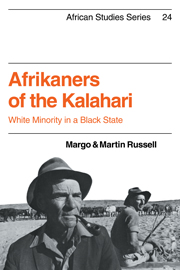Book contents
- Frontmatter
- Contents
- List of illustrations
- Acknowledgements
- A note on terminology
- 1 Southern Africa
- 1 The mundane Kalahari: an introduction
- 2 Boers, trekboers and bywoners: 1898–1930
- 3 Into the cash economy: 1930–72
- 4 Ghanzi Afrikaners 1973: a domestic description
- 5 Preserving boundaries: similarities, ambiguities and avoidances
- 6 Boers and Bushmen: dependence, interdependence and Independence
- 7 Sharing religion: attitudes to the conversion of the Bushmen to Christianity
- 8 Boers, bureaucrats and blacks
- 9 Prospect: whites in a black state
- Notes
- Bibliography
- Index
3 - Into the cash economy: 1930–72
Published online by Cambridge University Press: 04 August 2010
- Frontmatter
- Contents
- List of illustrations
- Acknowledgements
- A note on terminology
- 1 Southern Africa
- 1 The mundane Kalahari: an introduction
- 2 Boers, trekboers and bywoners: 1898–1930
- 3 Into the cash economy: 1930–72
- 4 Ghanzi Afrikaners 1973: a domestic description
- 5 Preserving boundaries: similarities, ambiguities and avoidances
- 6 Boers and Bushmen: dependence, interdependence and Independence
- 7 Sharing religion: attitudes to the conversion of the Bushmen to Christianity
- 8 Boers, bureaucrats and blacks
- 9 Prospect: whites in a black state
- Notes
- Bibliography
- Index
Summary
In 1928 a trader with interests at Kalkfontein, 130 kilometres west of Ghanzi, brought the first lorry through Ghanzi. The lorry arrived in a roadless wilderness where deep shifting sand could seize a vehicle and hold it fast, finding its intrusive and destructive way into every part of the engine; where the jagged limestone of the ridge ripped tyres and snapped springs, and where seasonal rains could transform the desert tracks into a mire. In itself it seemed insignificant, but its arrival marked the beginning of the real involvement of Ghanzi in the modernising economy of cash. It cut the Ghanzi to Gobabis journey from four weeks to three days, and facilitated the more rapid flow of goods and services, slowly depriving the donkey teams of their labour-intensive purposes. It opened the distinction, at first slight, between those who had capital (usually cattle) to meet the demands of the changing situation, and those who did not. The quality of life began imperceptibly to change.
We stayed well and friendly before the lorries came. Before the trucks came there was no money. Cattle went for two shillings. A fat cow was worth fifteen shillings. If you wanted to go to Gobabis it was with ox wagon. And the return journey could take months. But it was a freer life. You could hunt and shoot, you could do what you liked.
- Type
- Chapter
- Information
- Afrikaners of the KalahariWhite Minority in a Black State, pp. 27 - 39Publisher: Cambridge University PressPrint publication year: 1979

